Low-carbon energy adoption: UK vs Europe
As the global race to reach net-zero emissions by 2050 continues, we often ask ourselves how the UK is performing in its decarbonisation compared to its European counterparts.
And electricity generation is one of the main priorities to achieve this, as technologies like Electric Vehicles and Green Hydrogen are entirely dependent on green electricity.
The BEIS insists that the UK is making great progress here, but we decided to take this into our own hands and use the amazing data provided by ourworldindata.org to compare the UK’s adoption of low-carbon electricity to a European benchmark.
Contents
- Low-carbon electricity
- Hydro electricity
- Wind electricity
- Solar electricity
- Nuclear electricity
- Geothermal electricity
- Is the UK > Europe in low-carbon energy adoption?
Low-carbon electricity
Let’s begin this analysis by looking at the UK’s overall ability to generate low-carbon electricity compared to other countries in Europe. Low-carbon energy sources here include nuclear and all renewables (wind, solar, biomass, etc).
From the map below, it is clear that the UK’s 54.13% of electricity generated from low-carbon sources is second-tier, behind the Scandinavian nations (hydro-reliant) as well as France (nuclear) and Switzerland (a mix).
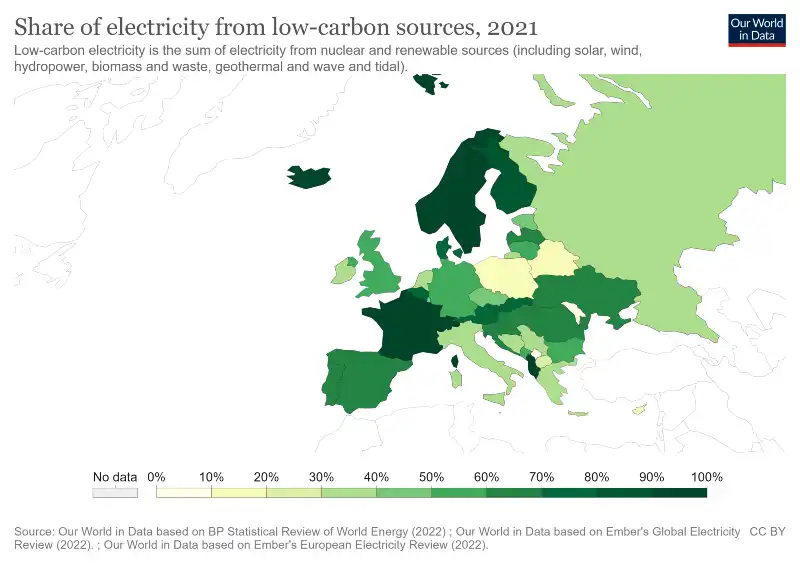
This second tier includes countries like Germany and the Netherlands, which have historically relied on their North Sea oil and gas and on-shore coal for electricity.
This two-tier split is clearly visible in the graph below, with the Netherlands clearly arriving late to the low-carbon party but doing so intensely as they rapidly catch up with the aggressive deployment of wind and solar onto their energy mix.
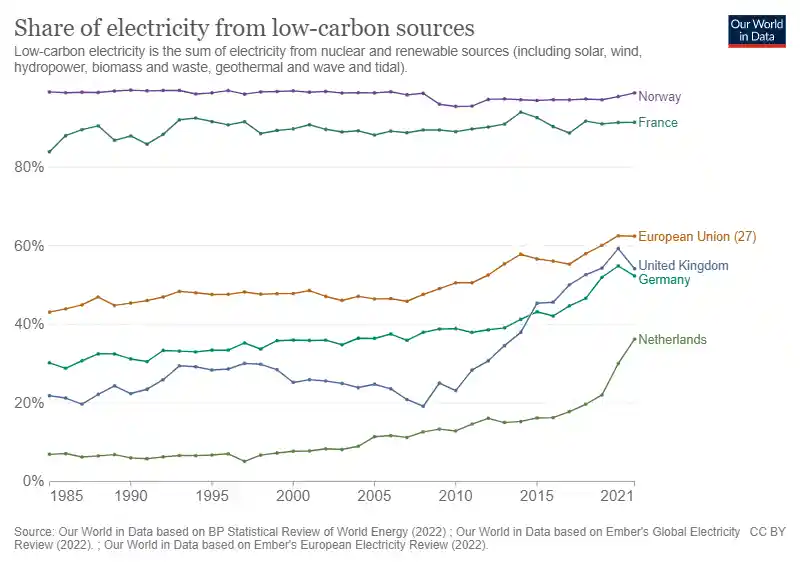
This sudden drop observed in Germany and the UK’s electricity production in 2021 is due to the reduced generation of wind energy that year due to a lack of wind.
Hydroelectricity
We all know that the UK’s ability to produce hydropower is hampered by its relatively flat geography compared to more mountainous countries.
Only 1.62% of electricity in the UK is produced from tens of micro hydropower stations, run-of-river schemes and hydro pump storage dotted around the country’s small mountains and hills.
Dinorwig hydropower pump storage station in North Wales is the largest in the UK, producing 1,800MW for the grid to supplement renewables when these are not producing as expected.
But more mountains do not necessarily mean more hydro, as is the case in France, Italy and Germany, which are all Alpine nations with enormous potential left untapped. Hydro has always been a matter of choice, and while France chose nuclear, Germany and Italy chose fossil fuels.
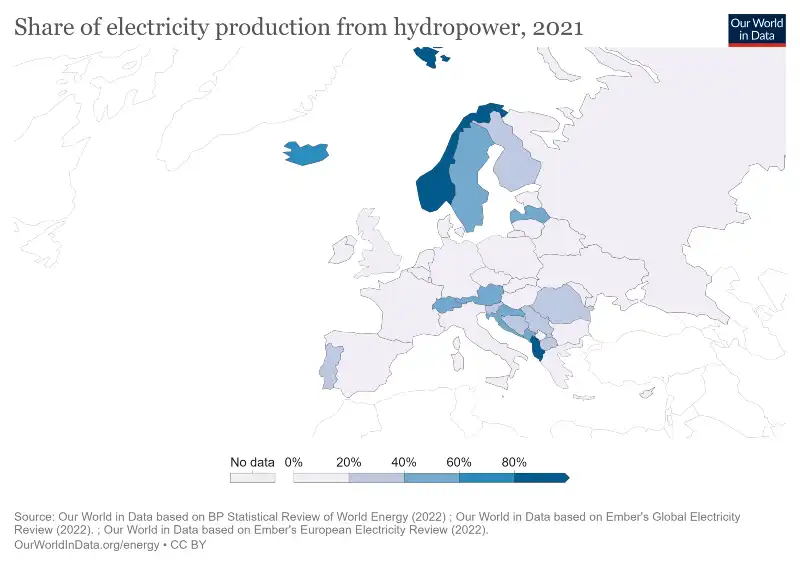
It is clear from the graph below that there hasn’t been an increase in the electrical output of hydro in Europe over the last 40 years, despite its potential for low-carbon electricity and storage.
One of the reasons for this is the expansion and development of protected areas in mountainous regions where these schemes are normally built, as well as the improved competitiveness and versatility of solar PV and wind energy.
Another issue is that hydro depends on the amount of water available, which climate change is dramatically changing as we are experiencing during this drought in 2022. This could become even more variable than solar and wind in consistency and intensity.
However, countries that pursued hydropower early on in their history (Norway, Iceland, Switzerland) are now reaping the rewards as their adaptation costs are significantly lower than other countries like Germany, the Netherlands and the UK that still rely heavily on fossil fuels.
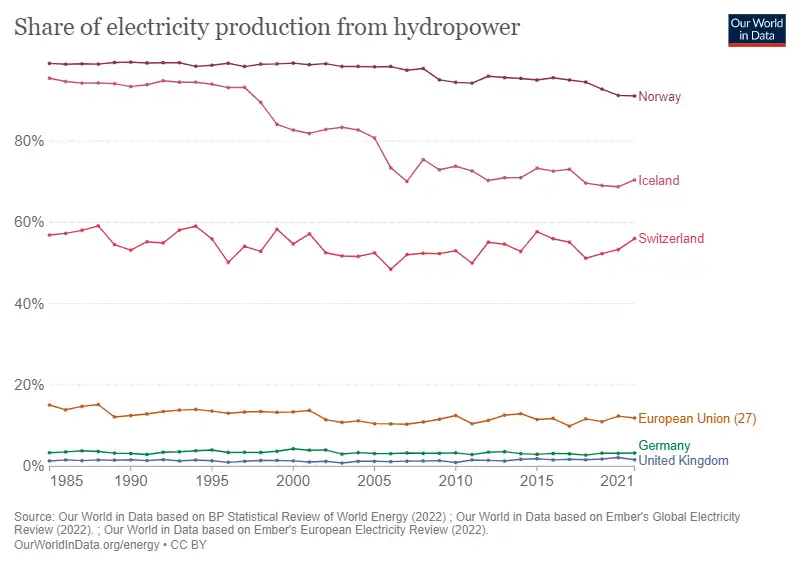
Wind electricity
The British Isles are blessed with an above-average wind profile compared to the rest of the world (see chart below), due to its direct exposure to the consistent supply of westerly winds brought over by the relentless gulf stream.
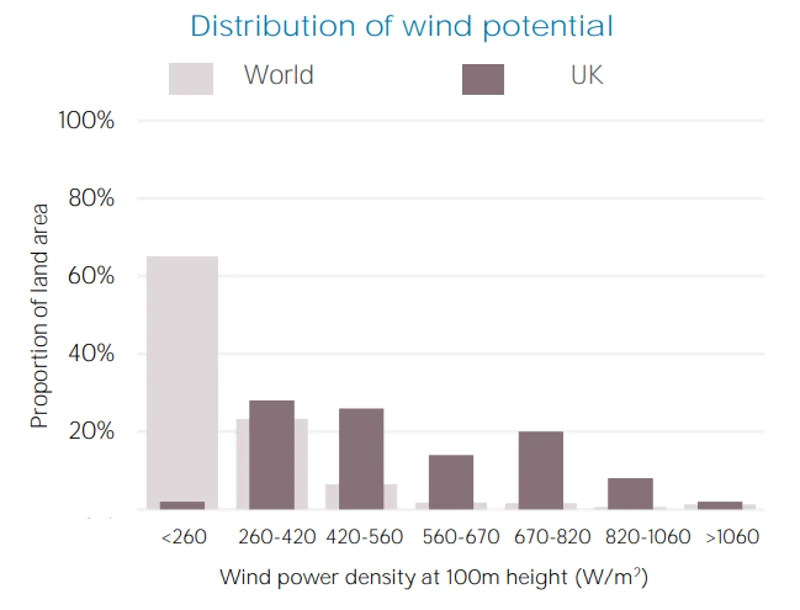
This has made the UK one of the leaders in the wind energy movement, producing a vast 20.8% of its electricity from its onshore and offshore UK wind farms.
This is clearly shown in the map below, which puts the UK amongst the European elite of countries generating over >20% of their electricity from wind. This elite also includes Ireland, Denmark, Germany, Portugal and Spain.
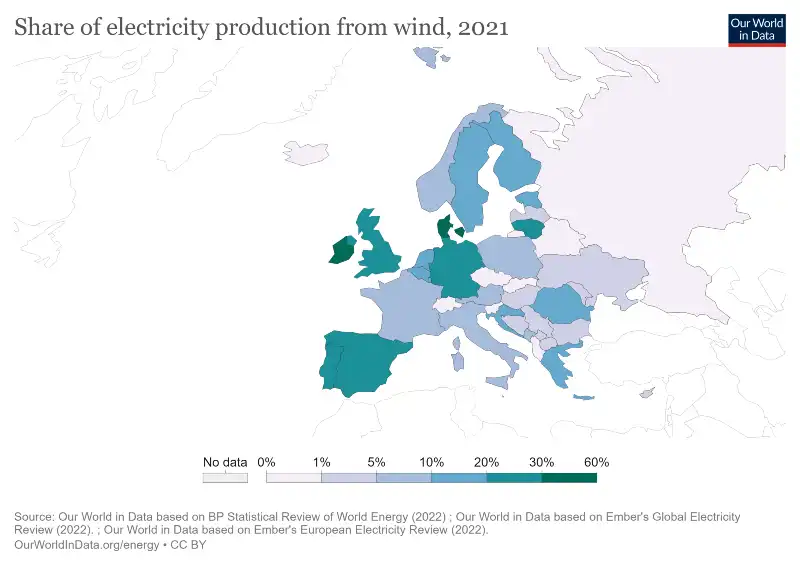
On top of this, the UK has the 3rd largest capacity installed in Europe with 27.1GW, behind only Germany (63.8GW) and Spain (27.5GW), and basically tripling any of the countries above, including Ireland and Denmark.
But despite this clear leadership in terms of total capacity installed, how does the UK compare to the rest of Europe when considering their entire contribution of wind electricity to the grid?
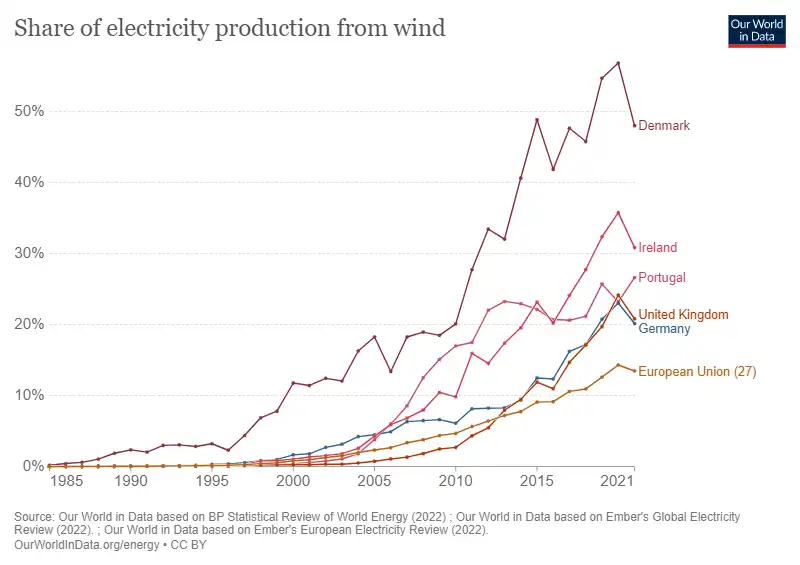
When considering the country’s total electricity, the Danish are the clear leaders and produce 48% of their electricity from their wind farms, followed by Ireland with 31%, both relatively small countries compared to the UK and Germany.
Wind energy implementation accelerated dramatically in the 2000s and has clearly made a larger impact in smaller countries where the total consumption of electricity is much smaller, and in the case of Denmark and Ireland, both have their entire geographies highly exposed to Atlantic winds.
Another thing to note from the graph is the susceptibility of wind energy to climatic conditions, with the infamous 2021 ‘windless’ year significantly affecting the output of all countries (except for Portugal).
Perhaps innovations like Airborne Wind Energy (using kites to tap into more reliable and powerful winds at altitude) will help smooth these sudden dips and make the wind industry more reliable.
Solar electricity
It is clear from the European solar electricity map below that Solar PV energy has really taken over, irrespective of the large differences in the solar potential of the Mediterranean countries compared to Northern Europe and the UK.
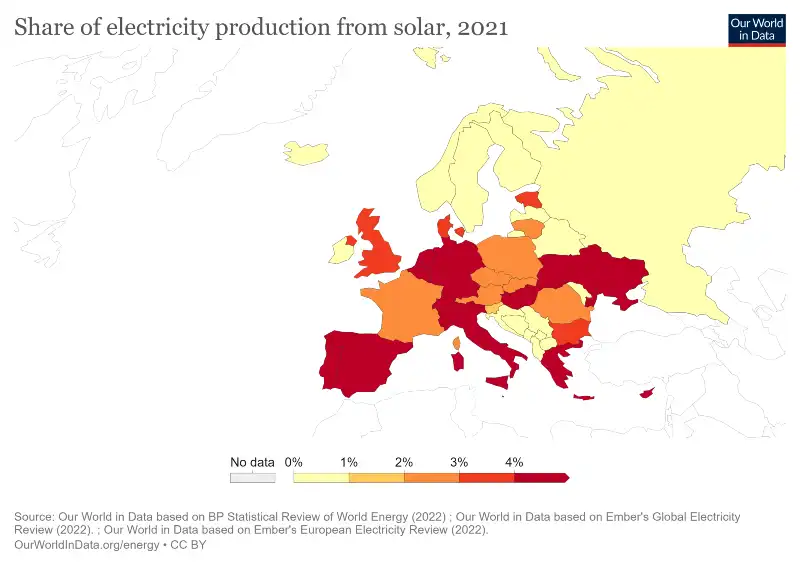
This is due to the versatility and cheap prices of solar PV units, which can be installed as individual units on small properties or turned into large solar PV farms.
Any differences observed between the different countries depend almost entirely on how well governments facilitate their implementation. So how does the UK compare to a mix of European countries?
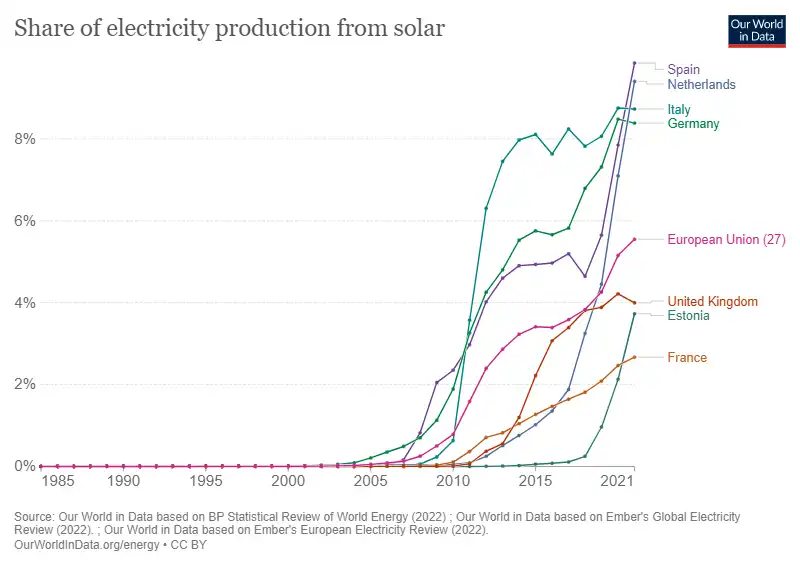
It is clear from the graph that the UK has recently experienced a significant deceleration in growth over the last five years, coincidental with the Brexit period.
The difference here clearly lies in governmental intervention. For example, the Netherlands have almost 80% of their solar energy coming from small <10kW installations, as they have been offering tax rebates, installation grants for homes and businesses, and credit for selling their solar to the grid.
To put it into an absolute context, the UK’s solar capacity of almost 14GW pales in comparison to Germany’s 50GW installed capacity which supplies just over 8% of its electricity needs, despite being at similar latitudes.
Without further incentives for solar PV installation in the UK, the country will inevitably keep lagging behind the rest of Europe.
Nuclear electricity
It is common knowledge that France is the uncontested nuclear powerhouse of Europe, with >60% of its electricity coming from its nuclear fission reactors.
However, other countries like Sweden, Finland, Belgium, Slovakia and Hungary are also significant nuclear electricity producers, and together bring the EU’s average to a significant 25%.
The UK produced 46TWh of energy from its 4 operating nuclear facilities in 2021, which meets 15% of the total electricity needs. Comparatively, there are 180 nuclear plants in Europe.
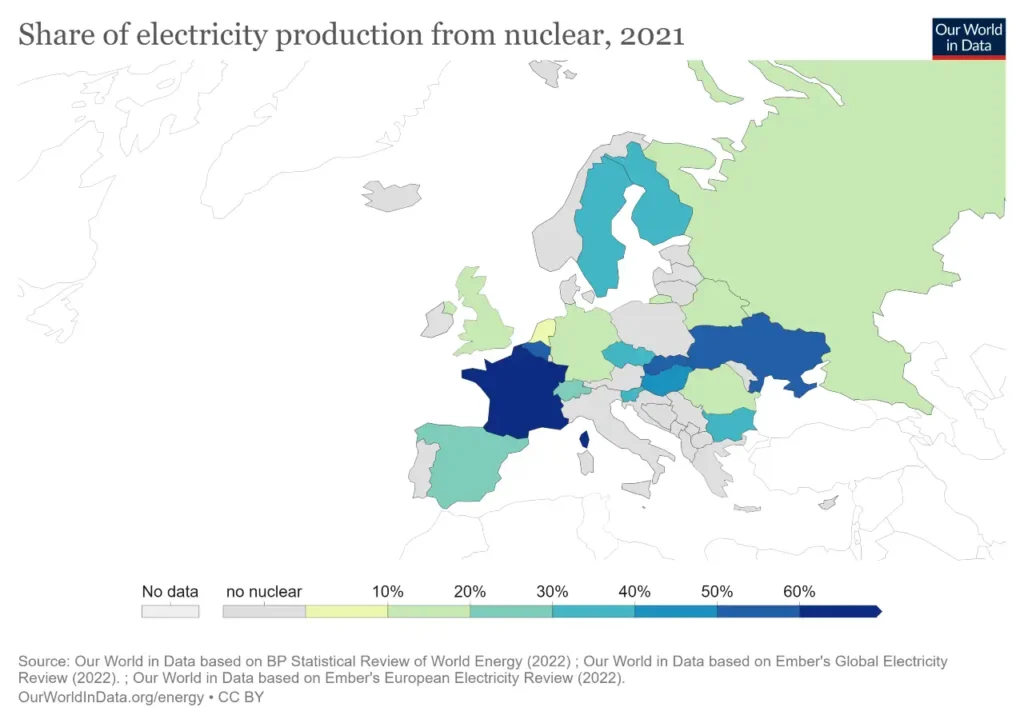
Similarly to hydro energy, nuclear output has remained relatively constant in Europe over the last 40 years, with a general decline as a result of general anti-nuclear sentiment, cheap fossil fuels and improvements in green energy technology.
In 1987, Britain produced 28% of its electricity from nuclear, which is almost double its proportion in 2021. The construction of a new reactor at Hinkley Point should significantly increase the UK’s nuclear capacity and low-carbon electricity generation.
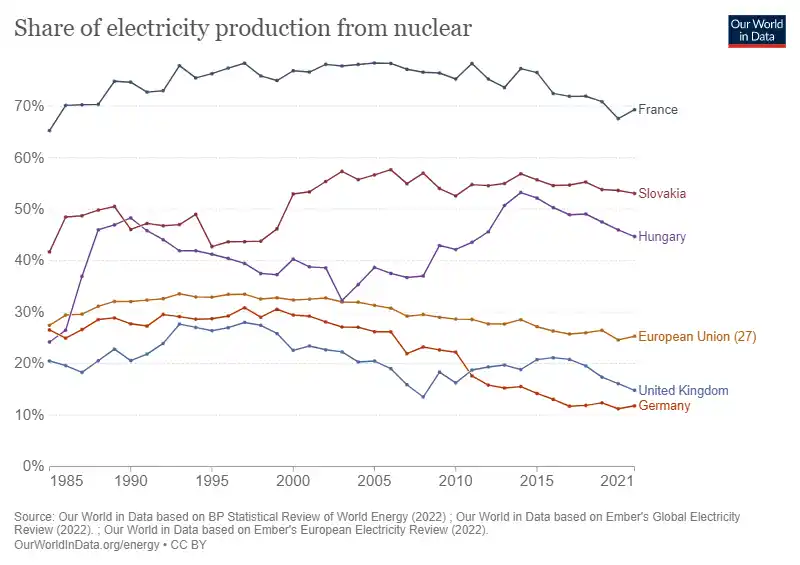
Interestingly, the only other European countries currently building nuclear reactors are Slovakia and France (Plus Turkey and Russia if you include these within Europe), showing the UK as one of the only other nations committed to a nuclear future.
Geothermal electricity
Honourary mention to Geothermal Energy, of which the UK produces a negligible amount (for heating purposes only) despite having significant resources in places like the South West of England.
However, the cost and accessibility of British geothermal resources pale in comparison to those of Iceland and Italy, which are the European geothermal leaders.
It is worth noting that the installed geothermal capacity runs in the 100s/10s of MW, which is in the range of 100 to 1000 times less in comparison to wind and nuclear capacities that run in the 100s/10s of GW.
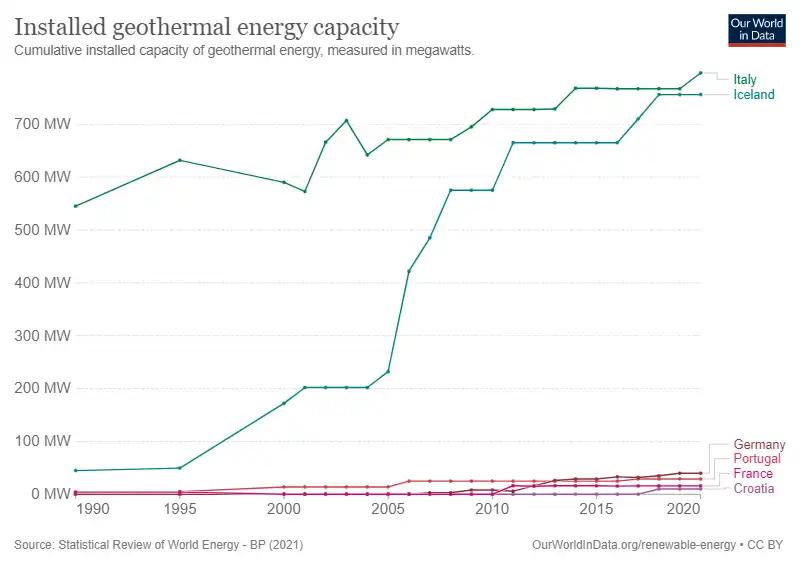
However, if the costs of geothermal energy decline over time, perhaps the UK will pioneer an increasing amount of projects, like those in Newcastle, Southampton and the Eden Project in Cornwall.
Is the UK > Europe in low-carbon energy adoption?
The UK’s historical reliance on natural gas and the large size of its population and industry have meant that it does have it tough compared to smaller nations that have historically met much of their demand from hydropower, and to France whose technocratic government has historically bet on nuclear energy.
Despite this and all of its governmental flaws, the UK has made significant strides in its implementation of wind energy and is one of only three European nations building a new nuclear reactor over the next decade. These are impressive feats in a regional context.
However, it is significantly falling behind in the implementation of solar energy, which is significantly aiding the low-carbon agendas of Germany and the Netherlands, which are also struggling behind the EU average low-carbon electricity adoption.
Perhaps if the controversial Drax power station does manage to implement its CCUS solution successfully and prove its sustainable biomass claims, this would add a significant, baseload low-carbon energy source.
So the UK is not doing as badly as we may have expected in a Europe-wide context, considering the political instability that we have seen since Brexit, and its historical neglect of renewables which is no different to other sophisticated European economies like Germany, the Netherlands and Italy.
However, it can certainly do better in some areas like solar PV, and perhaps even explore alternative possibilities like sand batteries.
At AquaSwitch, we only hope that the current energy crisis wakes up both the general population and the British government to do more about the UK’s green energy security.

